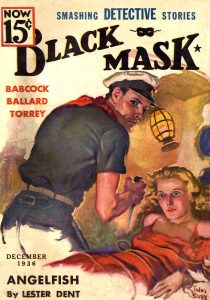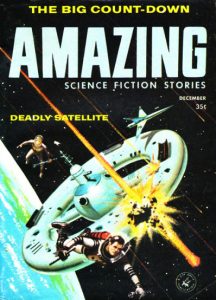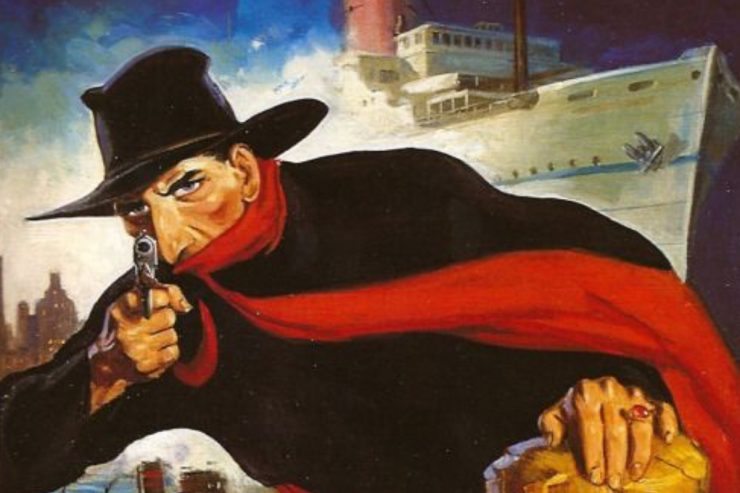 If you’ve been reading the posts on our website over the last few months, you should know that Daisy Bacon was THE editor of LOVE STORY MAGAZINE. After all, back in April, we wrote, “Under Bacon’s leadership, the magazine . . . headed to the stratosphere!”
If you’ve been reading the posts on our website over the last few months, you should know that Daisy Bacon was THE editor of LOVE STORY MAGAZINE. After all, back in April, we wrote, “Under Bacon’s leadership, the magazine . . . headed to the stratosphere!”
Contrary to popular belief, not all the female editors of pulp fiction magazines worked for the love pulps. According to historical accounts and memoirs, at least thirty women worked as the chief editors of magazines during the pulps’ heyday. About half of them managed pulps in other genres: detective, fantasy, hero, horror, science fiction, and western. And some of these women edited a romance pulp or two at the same time.
The magazines edited by women ranged from the popular — such as THE SHADOW and DOC SAVAGE — to magazines at the forefront of their genres — like BLACK MASK or WEIRD TALES — to obscure or one-issue titles, such as COSMOS SCIENCE FICTION AND FANTASY or CAPTAIN HAZZARD.
Like their male counterparts, female editors of pulp magazines came from a wide variety of backgrounds and all parts of the country. Some were college graduates, while others just finished high school. Their tasks were similar to male editors and there’s nothing to show that their responsibilities were any less. However, they were likely paid less than their male counterparts.
The women in charge of their magazines read the majority of manuscripts that arrived in the office, picked the best stories for their magazines, negotiated and bartered with authors, mentored new writers for their magazines, managed their staff, and dealt with office politics. Like male editors, they were instrumental in putting out successful magazines that contained the kind of stories that their readers desired.
 Some of these women are well known to pulp fans: Daisy Bacon, editor of LOVE STORY, DETECTIVE STORY MAGAZINE, and five other titles; Fanny Ellsworth, editor of RANCH ROMANCES for over 25 years and BLACK MASK MAGAZINE from 1936 to 1940; Mary Gnaedinger, editor of FAMOUS FANTASTIC MYSTERIES, FANTASTIC NOVELS, and A. MERRITT’S FANTASY MAGAZINE; and Dorothy McIlwraith, editor of SHORT STORIES and WEIRD TALES.
Some of these women are well known to pulp fans: Daisy Bacon, editor of LOVE STORY, DETECTIVE STORY MAGAZINE, and five other titles; Fanny Ellsworth, editor of RANCH ROMANCES for over 25 years and BLACK MASK MAGAZINE from 1936 to 1940; Mary Gnaedinger, editor of FAMOUS FANTASTIC MYSTERIES, FANTASTIC NOVELS, and A. MERRITT’S FANTASY MAGAZINE; and Dorothy McIlwraith, editor of SHORT STORIES and WEIRD TALES.
Despite their positions, these women often faced discrimination and received little recognition. Some saw their first names reduced to an initial on their magazines’ mastheads, to disguise the fact that the editor was a woman.
F. M. Osborne is listed as the editor for the first two years of BLACK MASK MAGAZINE. Florence M. Osborne was a woman. The editor of SHORT STORIES was D. McIlwraith.
A number of women replaced editors with intimidating reputations or inherited magazines going through difficult transitions. Fanny Ellsworth took over for the legendary Joseph Shaw at BLACK MASK. After the publisher of SHORT STORIES purchased WEIRD TALES, Dorothy McIlwraith replaced Farnsworth Wright. She was immediately faced with a boycott by authors loyal to Wright. They refused to send stories to her. Daisy Bacon was asked to ride herd over both THE SHADOW and DOC SAVAGE at a time when Street & Smith was more interested in developing their slick magazine line rather than continuing its pulps.
Despite the discrimination, lack of recognition, and limited financial rewards, several of these women contributed significantly to the fields in which they worked.
 Rose Wyn of Ace Periodicals worked with writer Paul Chadwick to create the pulp hero, Secret Agent X. Amita Fairgrieve is said to have come up with the concept of the love pulp magazine. Both Mary Gnaedinger and Dorothy McIlwraith, along with Cele Goldsmith-Lalli of AMAZING STORIES and FANTASTIC, are credited with substantial contributions to fantasy and science fiction. And according to the late Keith Alan Deutsch, “. . . BLACK MASK under Fanny Ellsworth was the inspiration, for the full emergence of the noir genre that has had an enduring impact on film and fiction in popular American and world entertainment.”
Rose Wyn of Ace Periodicals worked with writer Paul Chadwick to create the pulp hero, Secret Agent X. Amita Fairgrieve is said to have come up with the concept of the love pulp magazine. Both Mary Gnaedinger and Dorothy McIlwraith, along with Cele Goldsmith-Lalli of AMAZING STORIES and FANTASTIC, are credited with substantial contributions to fantasy and science fiction. And according to the late Keith Alan Deutsch, “. . . BLACK MASK under Fanny Ellsworth was the inspiration, for the full emergence of the noir genre that has had an enduring impact on film and fiction in popular American and world entertainment.”
On Friday, August 20, join PulpFest 2021 and Laurie Powers for “The Queen and Her Court — Leading Women Pulp Editors,” a look at Daisy Bacon, Fanny Ellsworth, Mary Gnaedinger, Dorothy McIlwraith, Marie Antoinette Park (who worked exclusively for the love pulps), Babette Rosmond, (editor of DOC SAVAGE and THE SHADOW), and other women who entertained the readers of the early twentieth century. Our presentation will take place at the DoubleTree by Hilton Hotel Pittsburgh – Cranberry, beginning at 7:55 PM.
Laurie Powers is the granddaughter of pulp author Paul S. Powers. She was introduced to the pulp community in 2007 through the publication of PULP WRITER: TWENTY YEARS IN THE AMERICAN GRUB STREET, her grandfather’s memoir of writing for the pulps. She has also edited several collections of her grandfather’s work in various genres, some featuring previously unpublished stories. Laurie is the author of QUEEN OF THE PULPS: THE REIGN OF DAISY BACON AND LOVE STORY MAGAZINE, published by McFarland Books in 2019. She also contributed the chapter, “Love on the Newsstands,” to IDW Publishing’s THE ART OF THE PULPS. A resident of Virginia, Laurie was honored in 2016 with the Munsey Award.
 The general public is welcome to attend our evening programming events. To learn more about our programming schedule, please click the Programming button at the top of this page.
The general public is welcome to attend our evening programming events. To learn more about our programming schedule, please click the Programming button at the top of this page.
For those who also want to enjoy our dealers’ room, you can join PulpFest by clicking the Registration button at the top of this page. And don’t forget to book a room at the DoubleTree. They’re going fast!
Mary Gnaedinger was the editor of FAMOUS FANTASTIC MYSTERIES through its complete 81-issue run, working for the Frank A. Munsey Company, and later, for Popular Publications. The July 1942 issue pictured above — featuring front cover art by Virgil Finlay — includes Francis Stevens’ novella, “Serapion.” Like editor D. McIlwraith of SHORT STORIES, writer Stevens was a woman. Her real name was Gertrude M. Barrows.
Captain Joseph T. Shaw was the editor of BLACK MASK from November 1926 through November 1936. In a letter to Philip Durham, Doc Savage author Lester Dent wrote, “Shaw was the finest coachwhip I ever met in an editor’s chair. In my thirty-five years of freelance fiction, no one stands out so.” Ironically, Dent’s hardboiled classic, “Angelfish,” appears in the first issue of BLACK MASK to be published after Shaw was fired. Dated December 1936 and featuring a cover by John Drew, the editor of the issue was Fanny Ellsworth.
According to science fiction scholar, Mike Ashley, when Cele Goldsmith-Lalli took over AMAZING STORIES in 1958, it was “at its worst, equating with the dullness of the Sloane era twenty years before. The magazine was read predominantly by young people, to whom it clearly appealed (a pen-pal column, “The Space Club,” brought responses mostly from readers in the 12-to-15 age range), but they were turning more to comics and television. The time was due to change AMAZING’s image again and seek a new market. Cele Goldsmith felt up to that challenge. She assumed the editorship of AMAZING with its December 1958 issue and started the climb back to glory.” Pictured here is Goldsmith’s first issue as editor — the December 1958 number — featuring front cover art by Ed Valigursky.
When Daisy Bacon became editor of DOC SAVAGE and THE SHADOW, both hero pulps were well past their prime. Before Bacon taking charge, both titles had experienced a revolving door of editors (including Babette Rosmond). To make matters worse, Street & Smith had turned its focus to building up its slick magazine line rather than continuing with its pulp line. Hoping to restore some of the two pulps’ former greatness, Bacon returned them to the pulp size and asked the premier SHADOW artist, George Rozen, to take on the front cover chores for both magazines. All was for naught: DOC SAVAGE hobbled on for three more issues, while THE SHADOW carried on for four. Our featured image is Rozen’s cover for the Fall 1948 issue of THE SHADOW, while the Winter 1949 DOC SAVAGE closes out our post. Both magazines represent the first issues of each title with Daisy Bacon at the helm.







